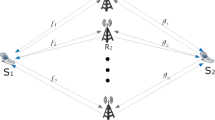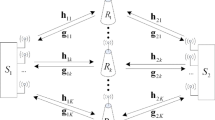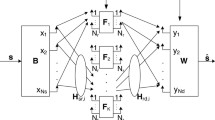Abstract
This paper proposes a new simple precoding solution based on the Gram–Schmidt orthonormalization to be used at the relay station of a multirelay wireless networks where the different mobile stations belong to the same network, in order to mitigate the multiuser interference at each mobile station. The strength of this method is that it only requires the knowledge of all channel impulse responses from a given relay to all the mobile stations. In other words, to compute its precoding vectors, each relay does not need to know the channel impulse responses of the channels of other relays. Unlike the centralized reference method where each mobile station benefits from the same diversity gain, using this algorithm, some mobile stations will improve their diversity gain at the cost of a loss in the diversity gain of other users. This constitutes a simple solution to supply different qualities of service in the case of a multiservices network. Furthermore, this work proposes an optimized power allocation between the relays. Analytical and accurate performance analyses for the different studied contexts are provided.












Similar content being viewed by others
Notes
Even when this is not the case, we can instruct the relays that did not succeed to correctly detect the information to be silent while the other L′ ≤ L relays with correctly decoded data will cooperate to send the signals to the MSs. The system can be seen as the same system with the number of relays decreased from L to L′
Note that the choice of unitary MPSK symbols is only for simplicity reasons. The results may be generalized for nonunitary symbols like quadrature amplitude modulation (QAM) constellations
For the use of EM algorithm in this context, see Appendix 2
Note that the chi-square distribution is a special case of the gamma distribution
References
Cover T, Gamal AE (1979) Capacity theorems for the relay channel. IEEE Trans Inf Theory 25(5):572–584
Laneman JN, Tse DNC, Wornell GW (2004) Cooperative diversity in wireless networks: efficient protocols and outage behavior. IEEE Trans Inf Theory 50(12):3062–3080
Borade S, Zheng L, Gallager R (2007) Amplify-and-forward in wireless relay networks: rate, diversity, and network size. IEEE Trans Inf Theory 53(10):3302–3318
Krikidis I, Thompson J, McLaughlin S, Goertz N (2008) Amplify-and-forward with partial relay selection. IEEE Commun Lett 12(4):235–237
Luo J, Blum RS, Cimini LJ, Greenstein LJ, Haimovich AM (2007) Decode-and-forward cooperative diversity with power allocation in wireless networks. IEEE Trans Wirel Commun 6(3):793–799
Wang T, Cano A, Giannakis GB, Laneman JN (2007) High-performance cooperative demodulation with decode-and-forward relays. IEEE Trans Commun 55(7):1427–1438
Wittneben A, Rankov B (2004) Distributed antenna systems and linear relaying for gigabit MIMO wireless. In: 2004 IEEE 60th vehicular technology conference, 2004. VTC2004-Fall, vol 5, pp 3624–3630
Yi Z, Kim I-M (2007) Joint optimization of relay-precoders and decoders with partial channel side information in cooperative networks. IEEE J Sel Areas Commun 25(2):447–458
Hammerstrom I, Kuhn M, Wittneben A (2004) Impact of relay gain allocation on the performance of cooperative diversity networks. In: 2004 IEEE 60th vehicular technology conference, 2004. VTC2004-Fall, vol 3, pp 1815–1819
Deng X, Haimovich AM (2005) Power allocation for cooperative relaying in wireless networks. IEEE Commun Lett 9(11):994–996
Gomadam KS, Jafar SA (2007) Optimal distributed beamforming in relay networks with common interference. In: IEEE global telecommunications conference, 2007. GLOBECOM ’07, pp 3868–3872
Ding Z, Chin WH, Leung KK (2008) Distributed beamforming and power allocation for cooperative networks. IEEE Trans Wirel Commun 7(5):1817–1822
Li J, Petropulu AP, Poor HV (2011) Cooperative transmission for relay networks based on second-order statistics of channel state information. IEEE Trans Signal Process 59(3):1280–1291
Betz SM, Poor HV, Petropulu AP (2007) Cooperative beamforming and power control. In: Conference record of the forty-first Asilomar conference on signals, systems and computers, 2007. ACSSC 2007, pp 2117–2123
Zhao J, Kuhn M, Wittneben A, Bauch G (2007) Cooperative transmission schemes for decode-and-forward relaying. In: IEEE 18th international symposium on personal, indoor and mobile radio communications, 2007. PIMRC 2007, pp 1–5
Lindblom J, Karipidis E (2010) Cooperative beamforming for the miso interference channel. In: 2010 European wireless conference (EW), pp 631–638
Nguyen DHN, Nguyen HH (2009) SNR maximization and distributed beamforming in multiuser multi-relay networks. In: IEEE global telecommunications conference, 2009. GLOBECOM 2009, pp 1–6, 4–30 Dec 2009
Liu Y, Petropulu AP (2010) Cooperative beamforming in multi-source multi-destination relay systems with SINR constraints. In: 2010 IEEE international conference on acoustics speech and signal processing (ICASSP), pp 2870–2873, March 2010
Xi S, Zoltowski MD (2006) Transmit beamforming and detection design for uplink multiuser MIMO systems. In: Fortieth Asilomar conference on signals, systems and computers, 2006. ACSSC ’06, pp 1593–1600, 1–29 Nov 2006
Xi S, Zoltowski MD (2008) SINR-Max cooperative beamforming for multiuser MIMO-OFDM systems. In: IEEE international conference on acoustics, speech and signal processing, 2008. ICASSP 2008, pp 3237–3240, 4–31 April 2008
Shu F, Gang W, Shao-Qian L (2009) Optimal multiuser MIMO linear precoding with LMMSE receiver. EURASIP J Wirel Commun Netw 2009:2:1–2:10
Meghdadi H, Meghdadi V, Cances J-P (2010) Performance analysis of a cooperative multiple access relaying scheme. In: IWCMC’10, pp 1065–1069
Larsson E, Jorswieck E (2008) Competition versus cooperation on the miso interference channel. IEEE J Sel Areas Commun 26(7):1059–1069
Pintelon R, Schoukens J (2001) System identification: a frequency domain approach, chapter some linear algebra fundamentals. Wiley and IEEE Press, New York, pp 413–434
Fessler JA, Hero AO (1994) Space-alternating generalized expectation-maximization algorithm. IEEE Trans Signal Process 42(10):2664–2677
Georghiades CN, Han JC (1997) Sequence estimation in the presence of random parameters via the em algorithm. IEEE Trans Commun 45(3):300–308
Cances JP, Meghdadi H (2010) Technical report, ENSIL/University of Limoges. http://perso.ensil.unilim.fr/∼cances/proof/IEEE_vt.pdf
Proakis JG (1983) Digital communications. McGraw-Hill, New York
Author information
Authors and Affiliations
Corresponding author
Appendices
Appendix 1: Proof of the characteristics of \(\lambda^2_{k,i}\)
Using Eq. 33, we can obtain the characterization of \(\lambda _{k,i}^{2}\) by mathematical induction
-
For i = 1, we have \(\mathbf e_{k,1}=\mathbf{h}_{k1} /\left\| \mathbf{h}_{k1}\right\|\) thus
$$ \label{eq:4-GS-lambda-i1} \lambda_{k,1}^{2} =\left|\left\langle \mathbf{h}_{k1},\mathbf e_{k,1} \right\rangle \right|^{2} =\left|\left\langle \mathbf{h}_{k1},\frac{\mathbf{h}_{k1}}{\left\| \mathbf{h}_{k,1}\right\| } \right\rangle \right|^{2} =\left\| \mathbf{h}_{k1} \right\| ^{2}. $$(92)Since h k1 is a vector of R complex Gaussian random components each of which with zero mean and a variance equal to 0.5, the random variable \(\lambda _{k,1}^{2} \) may be written as
$$ \label{eq:4-GS-lambda-i1-2} \lambda _{k,1}^{2} =\sum\limits_{i=1}^{R}\left|h_{k1}(i)\right|^{2} =\sum\limits_{i=1}^{R}\left[\left(h_{k1}^{R} (i)\right)^{2} +\left(h_{k1}^{I} (i)\right)^{2} \right]. $$(93)It is straightforward to conclude that \(\lambda _{k,1}^{2} \) is a chi-square variable with 2R degrees of freedom.
-
For i = 2, we have
$$ \label{eq:4-GS-E-i2} \mathbf e_{k,2}=\frac{\mathbf{h}_{k2} -\left\langle \mathbf e_{k,1} ,\mathbf{h}_{k2} \right\rangle\mathbf e_{k,1}}{\left\| \mathbf{h}_{k2} -\left\langle \mathbf e_{k,1} ,\mathbf{h}_{k2} \right\rangle \mathbf e_{k,1} \right\|}. $$(94)Hence, we obtain
$$\begin{array}{lll} \label{eq:4-GS-lambda-i2-1} \lambda _{k,2}^{2} &=&\left|\left\langle \mathbf{h}_{k2} ,\mathbf e_{k,2} \right\rangle \right|^{2}\\ & =&\left|\left\langle \mathbf{h}_{k2},\frac{\mathbf{h}_{k2} -\left\langle \mathbf e_{k,1} ,\mathbf{h}_{k2} \right\rangle \mathbf e_{k,1}}{\left\| \mathbf{h}_{k2} -\left\langle \mathbf e_{k,1} ,\mathbf{h}_{k2} \right\rangle \mathbf e_{k,1} \right\|} \right\rangle \right|^{2} \\ &=&\mu _{k,2}^{2}\left(\left\langle \mathbf{h}_{k2} ,\mathbf{h}_{k2} \right\rangle -\left|\left\langle \frac{\mathbf{h}_{k1}}{\left\| \mathbf{h}_{k1} \right\|} ,\mathbf{h}_{k2}\right\rangle \right|^{2} \right)\\ &=&\mu _{k,2}^{2}\left(\left\langle \mathbf{h}_{k2} ,\mathbf{h}_{k2} \right\rangle -\frac{\left|\left\langle \mathbf{h}_{k1} ,\mathbf{h}_{k2} \right\rangle \right|^{2} }{\left\| \mathbf{h}_{k1} \right\| ^{2} }\right). \end{array} $$(95)The term \(\left|\left\langle \mathbf{h}_{k1} ,\mathbf{h}_{k2} \right\rangle \right|^{2} \) can be calculated as
$$ \label{eq:4-GS-lambda-i2-2} \begin{array}{lll} \left\langle \mathbf{h}_{k1} ,\mathbf{h}_{k2}\right\rangle& =\sum\limits_{i=1}^{R}\left[h_{k1}^{R} (i)+j h_{k1}^{I} (i)\right]\left[h_{k2}^{R} (i)+jh_{k2}^{I} (i)\right] \\ &=\sum\limits_{i=1}^{R}\left[h_{k1}^{R} (i)h_{k2}^{R} (i)- h_{k1}^{I} (i)h_{k2}^{I} (i)\right]\\ &{\kern10pt}+j\sum\limits_{i=1}^{R}\left[h_{k,1}^{R} (i).h_{k,2}^{I} (i)+h_{k,1}^{I} (i).h_{k,2}^{R} (i)\right]. \end{array} $$(96)And this yields
$$ \label{eq:4-GS-lambda-i2-3} \begin{array}{lll}\frac{\left|\left\langle \mathbf{h}_{k1},\mathbf{h}_{k2}\right\rangle \right|^{2} }{\left\| \mathbf{h}_{k1} \right\| ^{2} } &=\frac{\sum_{i=1}^{R}\left[h_{k1}^{R} (i)h_{k,2}^{R} (i)- h_{k1}^{I} (i)h_{k2}^{I} (i)\right]^{2}}{\sum_{i=1}^{R}\left[\left|h_{k1}^{R} (i)\right|^{2} +\left|h_{k1}^{I} (i)\right|^{2} \right] } \\ &{\kern10pt}+\frac{\sum _{i=1}^{R}\left[h_{k1}^{R} (i)h_{k2}^{I} (i)+h_{k1}^{I} (i)h_{k2}^{R} (i)\right]^{2} }{\sum _{i=1}^{R}\left[\left|h_{k1}^{R} (i)\right|^{2} +\left|h_{k1}^{I} (i)\right|^{2} \right] }. \end{array} $$(97)Taking the mean of this expression and using the same approximation as in [8],
$$ \label{eq:4-GS-lambda-i2-approx} \mathbb{E}\left\{{\frac{\left|\left\langle \mathbf{h}_{k1}^{} ,\mathbf{h}_{k2}^{} \right\rangle \right|^{2} }{\left\| \mathbf{h}_{k1}^{} \right\| ^{2} } }\right\}\approx \frac{\mathbb{E}\left\{{\left|\left\langle \mathbf{h}_{k1}^{} ,\mathbf{h}_{k2}^{} \right\rangle \right|^{2}}\right\}}{\mathbb{E}\left\{{\left\| \mathbf{h}_{k1}^{} \right\| ^{2}}\right\}}. $$(98)Using the approximation in Eq. 98 after some mathematical developments, we get \(\mathbb{E}\left\{{\frac{\left|\left\langle \mathbf{h}_{k1}^{} ,\mathbf{h}_{k2}^{} \right\rangle \right|^{2} }{\left\| \mathbf{h}_{k1}^{} \right\| ^{2} } }\right\}=1\). This entails that the random variable \(\lambda _{k,2}^{2} \) is a chi-square variable with 2(R − 1) degrees of freedom.
-
As the last step of the induction, let us assume that the random variable \(\lambda _{k,i-1}^{2}\) is a chi-square random variable with \(2\left[R-(i-2)\right]\) degrees of freedom. We search to obtain the distribution of \(\lambda _{k,i}^{2}\). We have
$$ \label{eq:4-GS-lambda-i3-1} \begin{array}{lll} \lambda _{k,i}^{2} &=\,\mu _{k,i}^{2} \left[\,\left\langle \mathbf{h}_{ki}^{} ,\mathbf{h}_{ki}^{} \right\rangle -\sum\limits_{j=1}^{i-1}\left|\left\langle \mathbf e_{k,j}^{} ,\mathbf{h}_{ki}^{} \right\rangle \right| ^{2} \,\right]\\ &=\,\mu _{k,i}^{2}\left[\,\left\langle \mathbf{h}_{ki}^{} ,\mathbf{h}_{ki}^{} \right\rangle -\sum\limits_{j=1}^{i-2}\left|\left\langle \mathbf e_{k,j}^{} ,\mathbf{h}_{ki}^{} \right\rangle \right| ^{2} -\left|\left\langle \mathbf e_{k,i-1}^{} ,\mathbf{h}_{ki}^{} \right\rangle \right|^{2} \,\right]\,. \end{array} $$(99)Considering the hypothesis on \(\lambda _{k,i-1}^{2}\), we know that \(\left\langle \mathbf{h}_{ki}^{} ,\mathbf{h}_{ki}^{} \right\rangle -\sum _{j=1}^{i-2}\left|\left\langle \mathbf e_{k,j}^{} ,\mathbf{h}_{ki}^{} \right\rangle \right| ^{2} \) is a chi-square variable with \(2\left[R-(\textit{i}-2)\right]\) degrees of freedom. Subtracting the quantity \(\left|\left\langle \mathbf e_{k,i-1}^{} ,\mathbf{h}_{ki}^{} \right\rangle \right|^{2}\) and using the same method as the case i = 2, we can prove that \(\lambda _{k,i}^{2}\) is a chi-square random variable with \(2\left[R-(i-1)\right]\) degrees of freedom.
We proved that if the approximation in Eq. 98 is verified, the random variable \(\lambda _{k,i}^{2} \) is a chi-square random variable with \(2\left[R-(i-1)\right]\) degrees of freedom.
Appendix 2: Expectation–maximization algorithm
We want to approximate the pdf of random variables \(\lambda_{k,i}^2\). Based of the demonstration given under Appendix 1, we know that \(\lambda_{k,i}^2\) is a chi-square distributed random variable. Knowing that the chi-square distribution is a special case of gamma distribution
we will use the EM algorithm to calculate the values of α and β. EM is an iterative algorithm which alternates between performing an expectation step and a maximization step. Given a likelihood function \(L(\boldsymbol{\theta}; \mathbf{x})\), where \(\boldsymbol{\theta}\) is the parameter vector (α and β for a gamma distribution) and x is the n samples of observed data, the EM algorithm seeks to find the Maximum likelihood estimate (MLE) of the parameters by iteratively applying the following two steps:
-
Expectation step: Calculate the expected value of the log-likelihood function given x under the current estimate of the parameters \(\boldsymbol{\theta}^{(t)}=\left\{\alpha,\beta\right\}\). The likelihood function \(L(\boldsymbol{\theta};\mathbf{x},\mathbf{z})\) is related to the probability density function by
$$\label{eq:3-Likelihood1} L(\boldsymbol{\theta};\mathbf{x})=p(\mathbf{x}|\boldsymbol{\theta})=\prod\limits_{i=1}^n\frac{\beta^{\alpha}}{\Gamma(\alpha)}x_i^{\alpha-1}e^{-\beta x_i}. $$(101)The log-likelihood function is then determined by
$$\begin{array}{lll}\label{eq:3-logLikelihood1} \log L(\boldsymbol{\theta};\mathbf{x})= \sum\limits_{i=1}^n && \left[ \alpha \log\beta-\log\Gamma(\alpha)\right.\\ &&{\kern3pt}\left.+\,(\alpha-1)\log x_i-\beta x_i\right]. \end{array} $$(102)Since we are considering a single gamma distribution (and not a mixture of gamma distributions), there is no hidden variable, thus \(\mathbb{E}\left\{{\log L(\boldsymbol{\theta};\mathbf{x})}\right\}=\log L(\boldsymbol{\theta};\mathbf{x})\). Finally the expectation step then yields
$$\begin{array}{lll}\label{eq:3-E_step} &&Q(\theta|\theta^{(t)}) \triangleq \mathbb{E}\left\{{\log L(\theta;\mathbf{x})}\right\} \\ &&\sum\limits_{i=1}^n \left[\alpha \log\beta-\log\Gamma(\alpha)+(\alpha-1)\log x_i-\beta x_i\right].\\ \end{array} $$(103) -
Maximization step: Find the parameters which maximize the quantity Q(θ|θ (t)). In order to maximize Q(θ|θ (t)), the partial derivatives of this function must be calculated:
$$\begin{array}{lll}\label{eq:3-Beta_max} \frac{\partial Q(\theta|\theta^{(t)})}{\partial\beta}&=&0 \Longrightarrow \sum\limits_{i=1}^n\left(\alpha/\beta-x_i\right)\\&=&0\Longrightarrow \alpha=\beta\frac{\displaystyle\sum\limits_{i=1}^nx_i}{n}=\beta\bar{x_i} \end{array} $$(104)and
$$\label{eq:3-alpha_max} \begin{array}{lll} \frac{\partial Q(\theta|\theta^{(t)})}{\partial\alpha}&\,=\,0 \Longrightarrow\,\sum\limits_{i=1}^n\,\left[\,\log \beta - \frac{d\left(\log\Gamma(\alpha)\right)}{d\alpha}+\log x_i\,\right]\\ &=0\Longrightarrow\,\log\beta=\Psi(\alpha)-\frac{\displaystyle\sum\limits_{i=1}^n\log x_i}{n} \end{array} $$(105)where Ψ(x) denotes the digamma function (i.e., the polygamma function of order 0): \(\Psi(x)\equiv\psi_0(x)=\frac{\Gamma'(x)}{\Gamma(x)}\).
Substituting the value of β from Eq. 105 into Eq. 104, we obtain
$$\label{eq:x_fx} \alpha=\beta\bar{x_i}=\exp\left[\Psi(\alpha)-\frac{\displaystyle\sum\limits_{i=1}^n\log x_i}{n}\right]\bar{x_i} $$(106)which is clearly of form α = f(α) and thus can be calculated using the well-known Newton–Raphson method. The simulation results confirm that the gamma distribution obtained from this method fits the Monte Carlo results.
Rights and permissions
About this article
Cite this article
Meghdadi, H., Cances, JP. & Meghdadi, V. Simple precoding algorithms using Gram–Schmidt orthonormalization process for multiuser relay communications with optimized power allocation. Ann. Telecommun. 68, 247–266 (2013). https://doi.org/10.1007/s12243-012-0304-0
Received:
Accepted:
Published:
Issue Date:
DOI: https://doi.org/10.1007/s12243-012-0304-0




